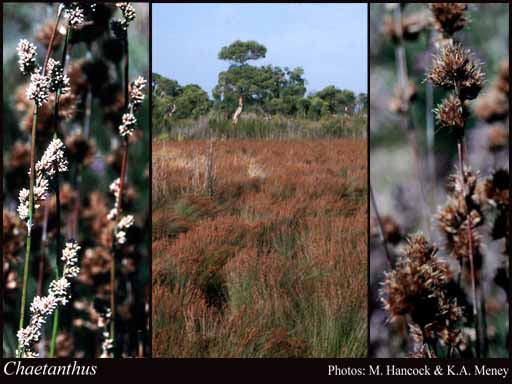- Reference
- Prodr.Fl.Nov.Holland. 251 (1810)
- Name Status
- Current

Scientific Description
Family Restionaceae.
Habit and leaf form. Herbs; evergreen. Switch-plants; with the principal photosynthesizing function transferred to stems (culms). Leaves well developed, or much reduced (the blade being much reduced or absent). Perennial. Young stems cylindrical (striate); not breaking easily at the nodes. Stem internodes solid, or hollow. Rhizomatous. Helophytic. Leaves alternate; distichous, or spiral; leathery, or membranous; sessile; sheathing (and more or less reduced to the sheaths). Leaf sheaths with free margins (few, persistent, appressed). Leaves simple; with a persistent basal meristem, and basipetal development. Vegetative anatomy. Plants with silica bodies. Leaf anatomy. Leaf blade epidermis conspicuously differentiated into ‘long’ and ‘short’ cells, or without differentiation into ‘long’ and ‘short’ cells. Guard-cells not ‘grass type’, or ‘grass type’. Stem anatomy. Secondary thickening absent.
Reproductive type, pollination. Fertile flowers functionally male, or functionally female. Unisexual flowers present. Plants dioecious. Female flowers with staminodes, or without staminodes. Male flowers with pistillodes, or without pistillodes. Floral nectaries absent (nectaries absent). Anemophilous.
Inflorescence and flower features. Flowers aggregated in ‘inflorescences’; in ‘spikelets’. Inflorescences scapiflorous, or not scapiflorous; terminal, or axillary; male and female inflorescences different. Flowers bracteate; bracteolate, or ebracteolate; cyclic. Perigone tube absent. Perianth of ‘tepals’; members 5, or 6; 2 -whorled; isomerous, or anisomerous; sepaloid. Fertile stamens present, or absent (when female). Androecium 3. Androecial members free of the perianth; free of one another; 1 -whorled. Androecium exclusively of fertile stamens. Stamens 3; remaining included; oppositiperianthial (opposite the inner perianth members). Anthers dorsifixed; versatile, or non-versatile; dehiscing via longitudinal slits; introrse, or latrorse; bisporangiate, or tetrasporangiate; appendaged, or unappendaged. Pollen shed as single grains. Fertile gynoecium present, or absent (male flowers). Gynoecium 3 carpelled. The pistil 1 celled. Carpels isomerous with the perianth, or reduced in number relative to the perianth. Gynoecium syncarpous; synstylovarious; superior. Ovary unilocular; 1 locular; sessile to stipitate. Gynoecium stylate. Styles 3; partially joined (basally). Ovules in the single cavity 1; funicled, or sessile; pendulous; non-arillate; orthotropous.
Fruit and seed features. Fruit non-fleshy; indehiscent; a nut (small, shed with enclosing glume, the fruiting perianth with awns or slender tepals 2–8 times as long as fruit); 1 seeded. Seeds copiously endospermic. Embryo weakly differentiated. Seedling. Hypocotyl internode absent. Mesocotyl absent. Seedling collar not conspicuous. Cotyledon hyperphyll elongated; assimilatory; more or less circular in t.s. Coleoptile absent. Seedling cataphylls absent. First leaf centric. Primary root ephemeral.
Additional characters Perianth of male flowers of ‘tepals’; 5 (tepals membranous). Perianth of female flowers of ‘tepals’; 6 (outer tepals rigid, acute or acuminate). Stems pubescent (with appressed ‘fan-hairs’); simple (below inflorescence). Male spikelets few-flowered, pendulous on slender branches at upper nodes. Caespitose. Female spikelets of flowers in clusters without conspicuous spikelet structure (in crowded clusters of 3–5 flowers forming compact heads, terminal or at several upper nodes). Male flowers with a globular swollen base. Pericarp thin-textured.